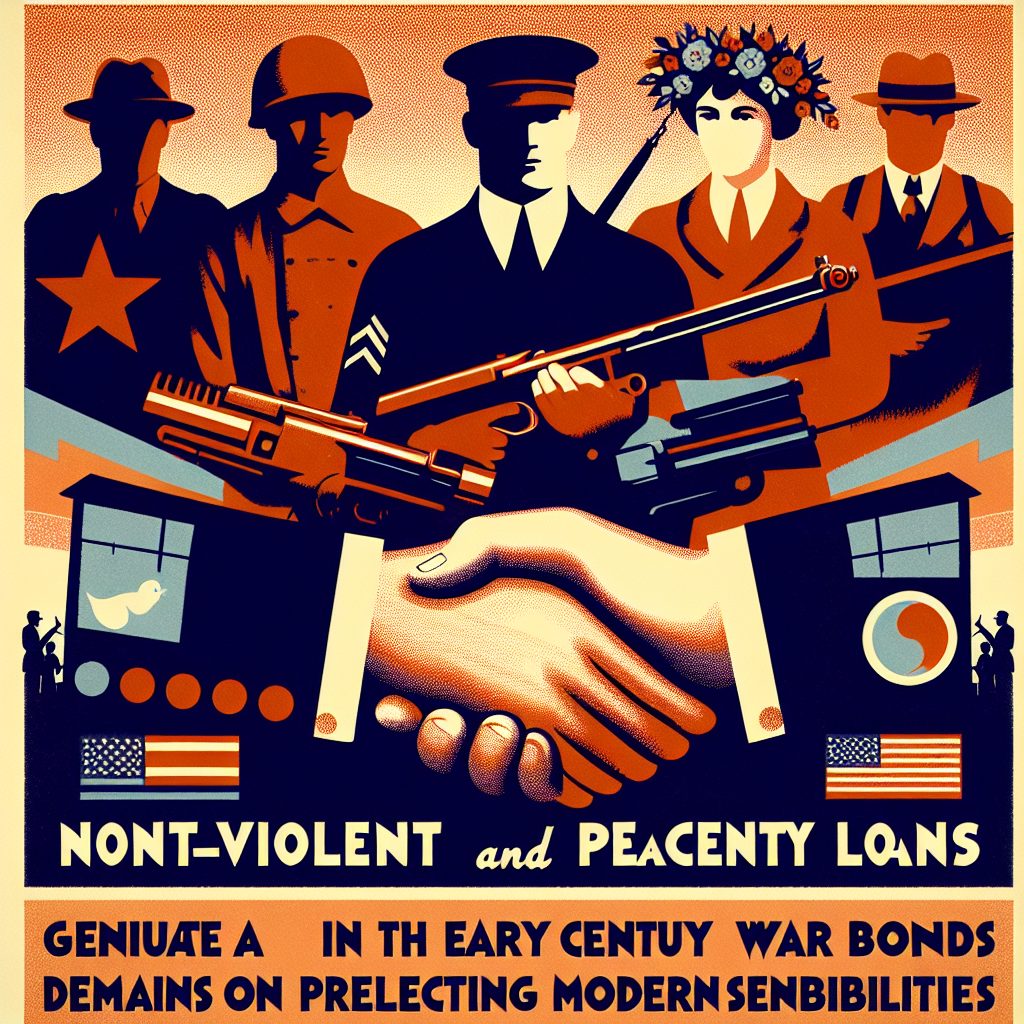Liberty Loans

“Empowering Your Financial Freedom with Liberty Loans“
Liberty Loans were a series of war bond drives in the United States during World War I, aimed at financing the American military effort. The government issued these bonds to citizens, encouraging patriotic support by appealing to a sense of civic duty and national pride. The bonds also helped to control inflation during a time of increased wartime spending. The Liberty Loan campaigns were a critical component of the U.S. financial strategy to mobilize resources for the war effort against the Central Powers. They were instrumental in involving the American public directly in the war effort and were a significant factor in the eventual Allied victory.
Unlock financial freedom with Liberty Loans! Get the support you need to achieve your dreams. Apply now at personalloansonlineinstantapproval.com and take the first step towards your financial goals.
The Historical Impact of Liberty Loans on American Society
Liberty Loans: The Historical Impact of Liberty Loans on American Society
In the annals of American history, the concept of Liberty Loans emerges as a pivotal financial mechanism that not only supported the United States during a time of great need but also fostered a sense of unity and patriotism among its citizens. Instituted during World War I, Liberty Loans were government-issued war bonds that provided the necessary funds to sustain the American military effort. The impact of these loans on American society was multifaceted, influencing the economic landscape, social dynamics, and the relationship between the government and its people.
Initially, the outbreak of World War I in 1914 found the United States in a position of neutrality. However, as the conflict progressed and the need for American involvement became apparent, the government faced the daunting task of financing an unprecedented military expedition. Traditional methods of raising funds through taxation or borrowing from foreign governments were deemed insufficient or undesirable. Consequently, the Treasury Department, under the leadership of Secretary William Gibbs McAdoo, introduced the concept of Liberty Loans to the American public.
The Liberty Loan campaigns were a revolutionary approach to war financing. They democratized the war effort by allowing ordinary citizens to contribute financially to the nation’s cause. By purchasing bonds, Americans of all socioeconomic backgrounds could lend money to their government and receive interest in return. This strategy not only generated the necessary capital but also instilled a sense of investment in the war’s outcome among the populace.
Moreover, the Liberty Loans campaigns were a masterclass in marketing and public persuasion. The government employed posters, parades, and celebrity endorsements to appeal to the citizens’ sense of patriotism and moral duty. The iconic image of Uncle Sam pointing his finger, exhorting Americans to “Buy Liberty Bonds,” became synonymous with the nationalistic fervor of the era. As a result, the campaigns were immensely successful, with millions of Americans participating and billions of dollars raised over the course of four separate bond drives.
The societal impact of Liberty Loans extended beyond the financial sphere. The campaigns served as a unifying force, bridging class divides and bringing together diverse segments of society for a common purpose. Women, who were still fighting for their right to vote, played a significant role in promoting and selling bonds, which not only contributed to the war effort but also bolstered their visibility and influence in public life.
Furthermore, the success of Liberty Loans had a lasting effect on the American financial system. The concept of mass participation in government securities laid the groundwork for future bond campaigns during times of crisis, such as World War II’s War Bonds. It also contributed to the development of a more robust and inclusive financial market, where the idea of investing in one’s country could be seen as both a patriotic act and a sound financial decision.
In retrospect, the Liberty Loans of World War I were more than just a means to an end; they were a transformative force in American society. They demonstrated the power of collective action and the potential for government and citizens to collaborate toward a shared goal. The legacy of Liberty Loans is evident in the continued use of government bonds to engage the public in national endeavors and in the enduring spirit of American patriotism that they helped to cultivate.
In conclusion, the historical impact of Liberty Loans on American society is profound. These bonds not only financed a war but also strengthened the fabric of the nation, fostering a sense of unity, financial innovation, and civic responsibility that resonates to this day. As we reflect on the past, the story of Liberty Loans serves as a testament to the enduring power of a people united in purpose and action.
Understanding Liberty Loans: A Comprehensive Guide

Liberty Loans, a term that resonates with historical significance, were war bonds issued in the United States during World War I to support the allied cause. These financial instruments were a patriotic call to the American public, enabling citizens to lend money to the government to fund military operations during a time of need. Understanding Liberty Loans is crucial for comprehending the economic and social dynamics of the era, as well as the role of public finance in wartime.
The genesis of Liberty Loans can be traced back to 1917 when the United States entered World War I. The government required an immense amount of resources to support the war effort, and traditional means of funding were insufficient. Consequently, the concept of war bonds was introduced, appealing to the citizens’ sense of patriotism. The Liberty Loan program was a series of loans with the first being issued in April 1917, and subsequent issues following over the next couple of years.
Liberty Loans were unique because they allowed individuals from all walks of life to participate in the war effort financially. The bonds were marketed extensively, using posters, speeches, and rallies to encourage Americans to demonstrate their patriotism by purchasing them. They were available in denominations as low as $50, making them accessible to a broad segment of the population. This inclusivity not only raised the necessary funds but also fostered a sense of unity and collective effort across the nation.
The interest rates on these bonds were relatively modest, typically around 3.5 to 4 percent, but the real return for many investors was the emotional reward of supporting their country. Moreover, the bonds were tax-exempt, which added a financial incentive to their purchase. Over the course of the war, four Liberty Loan drives were conducted, and each was met with increasing enthusiasm from the public. By the end of the war, millions of Americans had purchased Liberty Bonds, raising billions of dollars for the war effort.
The success of Liberty Loans was not only measured in financial terms but also in the way they galvanized the nation. The program was a testament to the power of collective action and the willingness of the American people to support their government in a time of crisis. It also set a precedent for future war bonds, which were issued during World War II under the name “War Savings Bonds” and popularly known as “Victory Bonds.”
In retrospect, Liberty Loans offer a fascinating glimpse into the intersection of finance, patriotism, and public engagement. They were a financial instrument that served a dual purpose: funding the war and fostering national solidarity. The program’s success demonstrated the effectiveness of appealing to citizens’ sense of duty and the power of financial tools in mobilizing resources for a national cause.
Today, the concept of Liberty Loans continues to be relevant as governments and organizations seek ways to finance large-scale endeavors, whether they be for wartime efforts or for addressing global challenges such as climate change. The principles of public engagement, patriotism, and collective responsibility that underpinned the Liberty Loan program remain potent forces that can be harnessed to drive societal progress.
In conclusion, Liberty Loans were more than just a means of wartime financing; they were a symbol of American unity and resolve. Understanding these bonds provides insight into the ways in which financial mechanisms can be employed to not only raise funds but also to build a sense of common purpose among a nation’s citizenry. As we reflect on the historical significance of Liberty Loans, we can appreciate the enduring power of finance to shape not just economies, but also the very fabric of society.
Liberty Loans and Their Role in Financing World War I
Liberty Loans and Their Role in Financing World War I
The outbreak of World War I in 1914 set the stage for an unprecedented mobilization of resources, as nations across the globe were plunged into a conflict of colossal scale. The United States, which entered the war in 1917, faced the daunting task of financing its military engagement without crippling its economy. This challenge led to the creation of Liberty Loans, a series of war bonds that played a pivotal role in the American financial strategy during the war years.
Liberty Loans emerged as a financial instrument designed to cover the extraordinary expenses associated with war. Rather than solely relying on taxation or depleting the gold reserves, the U.S. government sought to engage the American public directly in the war effort by appealing to their sense of patriotism. These government-issued bonds were essentially a promise to repay the borrowed amount with interest after a certain period. By purchasing Liberty Bonds, citizens were lending money to their government, thereby funding the military and its operations.
The success of Liberty Loans hinged on a widespread public relations campaign that permeated American society. The government, along with private organizations, launched an extensive marketing effort that included posters, parades, and celebrity endorsements. These campaigns were not only effective in raising funds but also in fostering a sense of unity and purpose among the American populace. The message was clear: buying Liberty Bonds was not just a financial investment, but a moral duty to support the cause of freedom and democracy.
The Liberty Loan program consisted of several bond issues, each with its own terms and interest rates. The first Liberty Loan Act was passed in April 1917, shortly after the U.S. entered the war. This initial offering set the precedent for subsequent issues, which were released periodically throughout the conflict. The bonds were made accessible to a broad segment of the population by allowing small denominations, which enabled people from various economic backgrounds to participate.
The financial impact of Liberty Loans was significant. Over the course of the war, millions of Americans purchased bonds, which collectively raised billions of dollars. This influx of capital was crucial in covering the costs of equipping, training, and deploying American forces overseas. It also helped to stabilize the economy by curbing inflationary pressures that typically accompany war spending.
Moreover, the Liberty Loan program had a lasting influence on the American financial landscape. It introduced many citizens to the concept of government securities and investment, which had long-term implications for the development of the U.S. bond market. The widespread participation in the bond purchases demonstrated the potential for mass involvement in national financial initiatives, setting a precedent for future government bond programs.
In conclusion, Liberty Loans were instrumental in financing the American effort in World War I. Through a combination of patriotic appeal and financial incentive, they mobilized the nation’s resources and fostered a collective investment in the war’s outcome. The success of the Liberty Loan program reflects the power of a united citizenry in supporting their government during times of crisis. It stands as a testament to the role that financial policy can play in shaping the course of history, and the enduring connection between national security and economic stability.
Q&A
1. What were Liberty Loans?
Liberty Loans were war bonds that were sold in the United States to support the allied cause in World War I. They were a means to raise funds for the war effort from the American public.
2. How many Liberty Loan drives were there during World War I?
There were a total of five Liberty Loan drives during World War I, occurring between 1917 and 1919.
3. What was the purpose of Liberty Loans?
The purpose of Liberty Loans was to finance the United States’ involvement in World War I by borrowing money from the American population, thereby allowing citizens to lend money to the government to cover the costs of war and support the troops overseas.Liberty Loans were a series of war bonds issued by the United States government during World War I to support the allied cause. They were instrumental in raising funds for the war effort, engaging the American public in the war, and fostering a sense of patriotism and duty. The success of Liberty Loans demonstrated the public’s willingness to finance the war and contributed significantly to the United States’ ability to provide military and economic support to the Allies, which was a crucial factor in the eventual victory.



